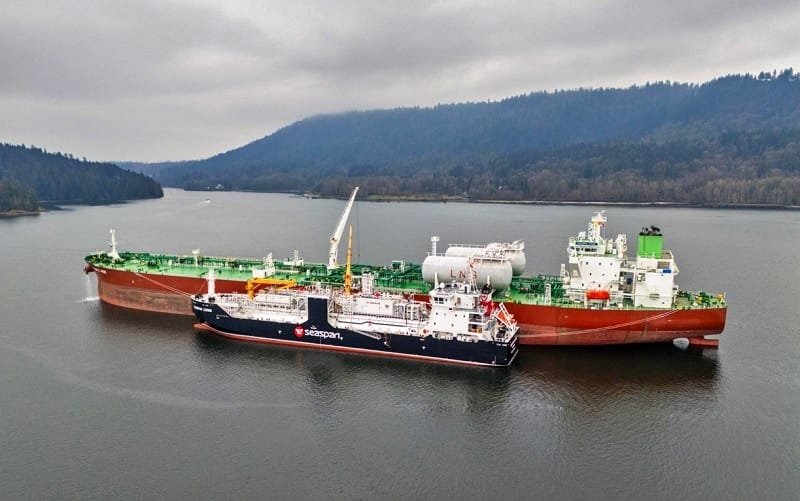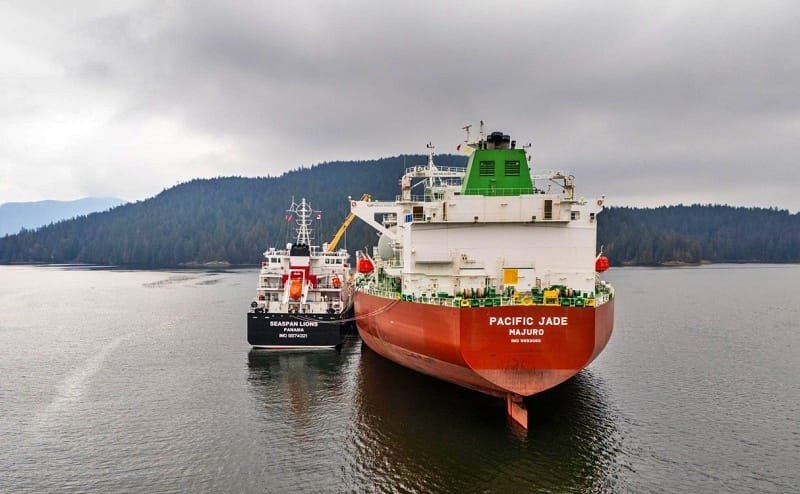Seaspan Energy, A Key Player in the alternative marine fuel market, has successfully completed its first ship-to-ship LNG bunkering operation in Canada, marking a significant milestone for the company and the country’s maritime industry. The operation took place in the Port of Vancouver’s Upper Harbour, a crucial hub for maritime activity on the West Coast of North America.
The ship-to-ship LNG bunkering was carried out by the Seaspan Lions, one of Seaspan Energy’s specialized LNG bunkering vessels. The vessel is named after the twin peaks of the North Shore, referred to as Ch’ich’iyúy Elxwíkn or the “Twin Sisters” in the Squamish Nation’s language. This symbolic name emphasizes the deep cultural and environmental connections to the region.
This event not only highlights Seaspan Energy’s commitment to sustainability but also introduces a significant low-carbon fuel alternative for ships operating in and around the Port of Vancouver. The LNG bunkering was performed to a tanker at anchor, marking a pivotal development in Canada’s efforts to support the decarbonization of maritime transportation.
“Completing our first successful bunkering in local waters is a major milestone for Seaspan Energy and marks the introduction of a low-carbon fuel alternative from the Port of Vancouver and beyond,” said Harly Penner, President of Seaspan Energy. “With two of our LNG bunkering vessels now operational and our first bunkering in the books, our message to ship owners globally is that we now offer an accredited LNG bunkering option here in Vancouver.”
Seaspan Energy’s latest achievement follows the completion of its first ship-to-ship LNG bunkering in December 2024 at the Port of Long Beach, California, which served a containership. This success marks the company’s growing role in the global LNG fuel market, particularly along North America’s West Coast.
The company’s fleet includes three state-of-the-art 112-meter-long LNG bunkering vessels, strategically positioned to serve the growing demand for cleaner marine fuels in the region. As the LNG fuel market continues to mature and evolve, Seaspan Energy is well-positioned to expand its services and cater to the increasing demand for low-carbon energy sources in the maritime industry.

The Role of LNG Bunkering in Emission Reduction
LNG, a natural gas that is cooled to -160°C to become a liquid, is a key enabler of emissions reduction in the maritime industry. By replacing conventional marine fuels, LNG significantly reduces harmful emissions, including sulfur oxides (SOx), nitrogen oxides (NOx), and particulate matter, making it a cleaner fuel option for shipping.
As part of the global effort to reduce emissions from shipping, LNG is increasingly being adopted by vessels worldwide. With the Port of Vancouver now supporting LNG bunkering operations, the port is helping the maritime industry transition to cleaner fuels and contribute to global decarbonization targets.
About Seaspan Energy
Seaspan Energy is a division of Seaspan Marine, a distinguished group of Canadian companies with a rich history in ship assistance, coastal and deep-sea transportation, ferry services, and fuel bunkering on the West Coast of North America. With over a century of expertise in coastal commerce, Seaspan is a key player in the Pacific Northwest’s marine economy, providing essential services that contribute to the sustainability and efficiency of the region’s maritime operations.
Seaspan Energy’s successful completion of Canada’s first ship-to-ship LNG bunkering is a testament to its leadership in the global transition to cleaner marine fuels, enhancing its position as a reliable partner for ship owners seeking eco-friendly fueling solutions.
Source Seaspan Energy

